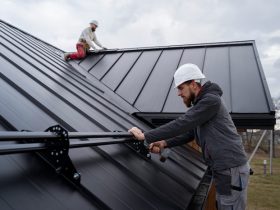As a homeowner, one of the biggest investments you make in your home is its roof. Choosing the right roofing material is crucial not just for curb appeal but also for functionality, durability, and even energy efficiency. Two of the most popular residential roofing options are metal and asphalt shingle roofs, but how do you decide which is right for your home?
Aside from considering the list of pros and cons of these roofing materials, there are other factors to weigh when making this decision. Some of these include:
1. Upfront Cost
The metal roof costs more upfront—that’s no secret. But don’t let the sticker shock deter you. With shingles, you may need to replace them every couple decades as they’re more prone to cracks and leaks.
Metal roofs, on the contrary, can remain watertight and protective for 50+ years with little to no maintenance required. This means you’d have to install at least two or three shingle roofs within the lifetime of just one metal roof.
So, if you take the long view, higher quality metal roofs can provide outstanding return on investment down the road. The key is finding an experienced contractor who can help determine appropriate materials for your home, while staying within your budget.
2. Weight
A potential downside of metal roofs is their weight. Due to this, they require additional roof decking and support. So, if your current roof decking cannot handle the load of a metal roof, additional structural upgrades and reinforcements would increase your installation costs.
Luckily, shingle options are lighter and usually do not require decking upgrades. If you’re on a budget and prefer lighter roofing materials, go with shingle roofs.
3. Durability And Resilience
When evaluating metal vs. shingles, consider the roofing material’s overall durability and resilience. Metal roofing is exceptionally tolerant of all types of weather due to the thick gauge steel or aluminum. It also comes with a protective finish that prevents corrosion or penetration of moisture. The robust materials, along with seamed panel construction, allow metal roofs to withstand extreme wind, heavy rainfall, hail, ice dams, and snow accumulation while remaining watertight.
Meanwhile, asphalt shingles offer less protection against severe storms and hail. They also become brittle and crack over time after years of sun exposure and expansion or contraction cycles in fluctuating temperatures.
In terms of fire safety, Class A fire-rated metal roofing remains reliable even in extreme heat up to 1,300°F thanks to non-combustible construction. On the other hand, asphalt shingles—essentially tar paper reinforced with ceramic granules—burn easily at much lower temperatures and ember exposure.
4. Energy Efficiency
One remarkable yet underrated advantage of metal roofs over shingle options is their significant energy cost savings during both warm and cool weather. Some metal roofing materials are engineered with the latest architectural innovations to minimize heat transfer year-round. This provides a stable, comfortable indoor climate that cuts back your energy usage substantially.
In summer, highly reflective metal roof coatings can minimize solar heat absorption by over 50% compared to standard dark asphalt shingles. This “cool roof” effect reduces heat radiating into your attic and living spaces, so your AC runs less frequently and intensely. By limiting heat buildup, metal roofing may save up to 15% on summer cooling bills in hot climates.
In winter months, the air-tight construction, non-conductive materials, and efficient attic insulation integration of modern metal roofs prevent the escape of heated indoor air upwards. This equates to up to 25% winter heating cost reductions for many homeowners after installing properly insulated metal roofing. The enhanced insulation also minimizes temperature fluctuations and drafts inside for greater comfort.
When you tally up these non-negligible heating and cooling savings over decades, a reflective, super-insulated premium metal roof delivers outstanding ROI. The upfront investment pays itself back while making your home more comfortable year-round.
5. Design Options
If curb appeal is important, you’ll be glad to know that both metal and shingle roofs allow for plenty of aesthetic customization. Metal comes in diverse styles, which often mimic wood shakes, slate, shingles, or terra cotta tiles. In addition, the colors may range from solid neutrals to bold brights. For extra visual interest, you can mix and match the metal roofing’s panel styles and colors.
Asphalt shingles also offer various architectural styles, textures, patterns, and hues to fit your home’s exterior color scheme. You can even incorporate accent strips or decorative designs along ridges or edges as finishing touches.
6. Installation Time
The installation process itself differs notably between shingle and metal roofs. Asphalt shingles can generally be installed more swiftly, with the completion of simple gable roof projects often possible within a week.
In contrast, metal panels involve more components like clips, flashing, and trim that interconnect for waterproof seams. This multi-step process extends total installation time to potentially 2 to 3 weeks, depending on roof complexity, access constraints, and weather delays. Metal roofs may also call for wood decking enhancements if existing infrastructure cannot support the load, lengthening the installation process.
For homeowners who prioritize rapid project completion with minimal household hassle, shingle replacement would pose the least disruption, particularly on basic roof shapes without intricate architectural elements. However, the long-term benefits of metal roofing could outweigh several weeks of construction intensity for decades after.
7. Maintenance
When it comes to maintenance, metal roofing is just easier. Besides, occasional rinses to clear the gunk are no biggie. But asphalt shingles? More hassle, for sure.
Every few years, you need to inspect for wear and tear as the roof takes hits from the sun, rain, snow, and ice dams. Granules come loose, nails back out, and seals crack or curl. Anything that lets water underneath is bad news. Leaks lead to rot, repairs, or even replacement way before you planned.
So, if easy living is your style, low maintenance metal has an obvious appeal. However, if your budget is tighter, staying diligent on shingle upkeep works too. Just know either roof type needs some degree of your attention to maximize durability.
Final Thoughts
Both metal and shingle roofs are great options for your home’s roofing. But when making this big decision, consider your region’s climate, budget, desired longevity, aesthetics, and functionality. Weigh both the pros and cons carefully to determine the ideal choice. If you’re still unsure, consult a reputable roofer who can provide more personalized insights about which suits your home best.











Leave a Review